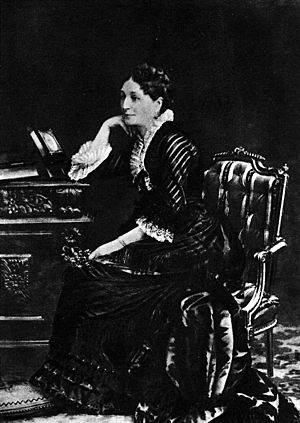Jane Loftus, Marchioness of Ely facts for kids
Jane Loftus, also known as the Marchioness of Ely, was born on December 3, 1821, and passed away on June 11, 1890. She was an important lady in the court of Queen Victoria and became a very close friend to the Queen. Jane's parents were James Hope-Vere and Lady Elizabeth Hay. Through her mother, she was a cousin of Arthur Wellesley, who was famous as the first Duke of Wellington.
After marrying John Loftus, the third Marquess of Ely, Jane also became friends with other important figures like Queen Sophie of the Netherlands and Empress Eugénie. Jane started working for Queen Victoria as a Lady of the Bedchamber in 1851. Even though she was sometimes nervous, she became a trusted companion to the Queen until she retired in 1889. Her time serving the Queen was sometimes difficult due to her health and her fear of upsetting the Queen. However, she was always very loyal and dedicated. Jane died on June 11, 1890, and was buried in Kensal Green cemetery in London.
Contents
Early Life and Family Connections
Jane was the daughter of James Hope-Vere, who was a Member of Parliament for Ilchester. Her mother was Lady Elizabeth Hay. Her father's family was connected to the Marquess of Linlithgow. Through her cousin Elizabeth, Lady Douro, Jane became friends with Arthur Wellesley, the first Duke of Wellington.
On October 29, 1844, Jane married John Loftus, who was the third Marquess of Ely. The couple spent a lot of their time on Ely's family lands in Ireland, such as Loftus Hall in County Wexford. They also traveled often to other countries in Europe. Jane made important friends during her travels. These friends included Queen Sophie of the Netherlands and Empress Eugénie. Jane even represented Queen Victoria at the birth of Empress Eugénie's son, Napoléon, Prince Imperial.
Serving Queen Victoria
Jane was chosen to be a lady of the Queen's bedchamber on July 15, 1851. This was an important role in the royal court. Jane was very hardworking, loyal, and dedicated to her duties. However, she sometimes lacked the experience and carefulness needed for the job.
In 1855, Mary Bulteel, who later married the Queen's private secretary Sir Henry Ponsonby, felt that Jane was too nervous. She thought Jane was "foolishly cringing" to the rules of the court. Mary wished the Queen had a first lady with more natural confidence.
A Trusted Companion
Despite these early concerns, Queen Victoria grew to depend a lot on Jane. The Queen often called her "Dearest Jane." Queen Victoria expected her servants to be very devoted and work hard. Jane followed these expectations completely, always putting the Queen first.
However, this dedication took a toll on Jane's health. She often felt unwell during her time serving the Queen. Henry Ponsonby once wrote that Jane was mostly worried about her own health. In 1876, Jane told Ponsonby that she felt her duties were "killing her." Ponsonby advised her to write to the Queen and say she would resign if her work wasn't made easier.
The Queen did make some changes, but she still limited Jane's contact with the outside world. Jane's son, who became the 4th Marquess after his father died in 1857, wanted to visit her. But the Queen would not allow it. He even asked to speak with Ponsonby about his mother's difficult duties. Jane, however, was afraid the Queen would not like it if Ponsonby met with her son. Ponsonby thought this fear of the Queen was unnecessary.
An Important Advocate
Even with her nervousness and health issues, Jane Ely quickly became one of the Queen's most trusted helpers. The Queen saw Jane as "almost one of ourselves." This shows how close they were, even though Victoria usually kept a distance from non-royals.
Jane became one of the most important "agents" for the Queen. Other ladies like Harriet Phipps and Horatia Stopford also held similar roles. People in the royal household often used Jane to speak to the Queen. They would ask her to get the Queen's approval for their plans. Many letters from important people in society mentioned Jane. This shows that her role as an unofficial secretary for the Queen was well known.
For example, when the Earl of Beaconsfield had a disagreement with the Queen, he wrote to Jane. He likely hoped she would show the letter to the Queen. He wrote that he loved the Queen and was worried when there was a "cloud" between them.
Later Life and Legacy
Jane's relationship with the Queen was very close. However, it became a bit strained for a short time when rumors spread that Jane might remarry. Lord Torrington mentioned that she might marry Robert St Clair-Erskine, Lord Loughborough. But Jane quickly said that these rumors were not true. There were also rumors of other possible partners, like Count Cavour, a leader from Piedmont.
After Princess Louise got married in 1871, Jane was asked to live with the Queen more often. She continued to serve the Queen until April 1889. After her only son passed away, Jane wrote to the Queen to resign. She explained that this sad event had "quite crushed" her.
After she resigned, Jane was given the special title of Extra Lady of the Bedchamber. She died on June 11, 1890, at her home in Wilton Place, Knightsbridge in London. She was buried next to her husband at Kensal Green cemetery. The Queen received a telegram from Jane's daughter about her death. Queen Victoria wrote in her journal that she was "much upset" and that Jane was an "awful loss." She said Jane was completely devoted to her and they were very close.
Images for kids



